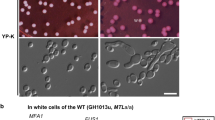Abstract
When cells of the dimorphic yeast Candida albicans are grown to stationary phase in defined liquid medium at 25°C, they accumulate as singlets in Gl of the cell cycle. When these pluripotent, stationary phase singlets are released into fresh medium at 37°C, they synchronously evaginate after an average period of 135 to 140 minutes and form either buds or mycelia, depending upon the pH of the medium into which they are released. This method of dimorphic regulation offers the distinct advantage of comparability and serves as a very precise method for temporal comparisons of molecular and cytological events related to the establishment of the alternate growth phenotypes. In the present report, we have carefully examined the effects of individually varying pH or temperature on the length of the pre-evagination period, the population synchrony for evagination, and the phenotype of daughter cells. Exact phenotypic transition points, optima, and upper limits are defined for both temperature and pH. In addition, a method of pH-regulated dimorphism is developed in which the original temperature shift is removed from the inductive process. Finally, a common transition phenotype is described for cells reverting from the initial mycelial to budding phenotype when either pH or temperature traverse their respective transition points. The advantages as well as limitations of pH-regulated dimorphism are discussed in detail.
Similar content being viewed by others
References
Auger, P. & Joly, J., 1977. Factors influencing germ tube production in Candida albicans. Mycopathologia 61: 183–186.
Bedell, G. & Soll, D. R., 1979. The effects of low concentration of zinc on the growth and dimorphism of Candida albicans: evidence for zinc resistant and zinc sensitive pathways for mycelium formation. Infect. Immun. 26: 348–354.
Bedell, G., Werth, A. & Soll, D. R., 1980. The regulation of nuclear migration and division during synchronous bud formation in released stationary phase cultures of the yeast Candida albicans. Exptl. Cell Res. 127: 103–113.
Byers, B., 1981. Cytology of the yeast life cycle. In: The Molecular Biology of the Yeast Saccharomyces: Life Cycle and Inheritance (Strathern, D. N., Jones, E. W. & Broach, J. R., eds.), pp. 59–96. Cold Spring Harbor Laboratory, Cold Spring Harbor, N.Y.
Brummel, M. & Soll, D. R., 1982. The temporal regulation of protein synthesis during synchronous bud or mycelium formation in the dimorphic yeast Candida albicans. Develop. Biol. 89: 211–224.
Cabib, E., 1975. Molecular aspects of yeast morphogenesis. Ann. Rev. Microbiol. 29: 191.
Chaffin, W. L. & Sogin, S. L., 1976. Germ tube formation from zonal rotor fractions of Candida albicans. J. Bacteriol. 126: 771–776.
Evans, E. G., Odds, F. C. & Holland, K. T., 1975. Optimum conditions for initiation of filamentation in Candida albicans. Can. J. Microbiol. 21: 338–342.
Lee, K. L., Buckley, H. R. & Campbell, H. R., 1975. An amino acid liquid synthetic medium for development of mycelial and yeast forms of Candida albicans. Sabourauria 13: 148–153.
Mattia, E. & Cassone, A., 1979. Inductibility of germ tube formation in Candida albicans at different phases of yeast growth. J. Gen. Microbiol. 113: 439–442.
McAlister, L. & Finkelstein, C. B., 1980. Alterations in translatable ribonucleic acid after heat shock of Saccharomyces cerevisiae. J. Bact. 143: 603–612.
McAlister, L., Strausberg, S., Kulago, A. & Finkelstein, D. B., 1979. Altered patterns of protein synthesis induced by heat shock of yeast. Curr. Genet. 1: 63–74.
Miller, M. J., Xuong, N. & Geiduschek, E. P., 1979. A response of protein synthesis to temperature shift in the yeast Saccharomyces cerevisiae. Proc. Natl. Acad. Sci. U.S.A. 76: 5222–5225.
Mitchell, L. & Soll, D. R., 1979. Commitment to germ tube or bud formation during release from stationary phase in Candida albicans. Exptl. Cell Res. 120: 167–179.
Mitchell, L. & Soll, D. R., 1979. Septation during synchronous mycelium and bud formation in released stationary phase cultures of Candida albicans. Exptl. Mycol. 3: 298–309.
Soll, D. R., 1983. Candida albicans. In: Fungal Dimorphism: with Emphasis on Fungi Pathogenic to Humans (Szaniszlo, P. J., ed.), Plenum Press, N. Y., in press.
Soll, D. R. & Bedell, G., 1978. Bud formation and the inducibility of pseudo-mycelium outgrowth during release from stationary phase in Candida albicans. J. Gen. Micro. 108: 173–180.
Soll, D. R. & Herman, M. A., 1983. Growth and inducibility of mycelium formation in Candida albicans: a single cell analysis employing a perfusion chamber. Submitted for publication.
Soll, D. R. & Mitchell, L., 1983. Filament ring formation in the dimorphic yeast Candida albicans. Journal of Cell Biology, in press.
Soll, D. R., Bedell, G. W. & Brummel, M., 1981. Zinc and the regulation of growth and phenotype in the infectious yeast Candida albicans. Infect. Immun. 32: 1139–1147.
Soll, D. R., Stasi, M. & Bedell, G., 1978. The regulation of nuclear migration and division during pseudo-mycelium outgrowth in the dimorphic yeast Candida albicans. Exptl. Cell Res. 116: 207–215.
Soll, D. R., Bedell, G., Thiel, J. & Brummel, M., 1981. The dependency of nuclear division on volume in the dimorphic yeast Candida albicans. Exptl. Cell Res. 133: 55–62.
Author information
Authors and Affiliations
Rights and permissions
About this article
Cite this article
Buffo, J., Herman, M.A. & Soll, D.R. A characterization of pH-regulated dimorphism in Candida albicans . Mycopathologia 85, 21–30 (1984). https://doi.org/10.1007/BF00436698
Issue Date:
DOI: https://doi.org/10.1007/BF00436698




